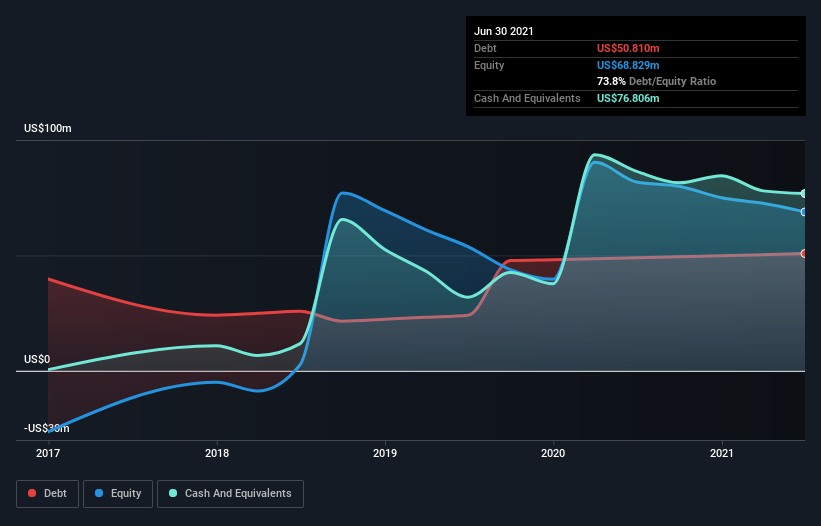Is Establishment Labs Holdings (NASDAQ:ESTA) Using Debt Sensibly?
Howard Marks put it nicely when he said that, rather than worrying about share price volatility, 'The possibility of permanent loss is the risk I worry about... and every practical investor I know worries about.' It's only natural to consider a company's balance sheet when you examine how risky it is, since debt is often involved when a business collapses. Importantly, Establishment Labs Holdings Inc. (NASDAQ:ESTA) does carry debt. But is this debt a concern to shareholders?
Why Does Debt Bring Risk?
Debt and other liabilities become risky for a business when it cannot easily fulfill those obligations, either with free cash flow or by raising capital at an attractive price. If things get really bad, the lenders can take control of the business. However, a more common (but still painful) scenario is that it has to raise new equity capital at a low price, thus permanently diluting shareholders. Of course, debt can be an important tool in businesses, particularly capital heavy businesses. The first thing to do when considering how much debt a business uses is to look at its cash and debt together.
See our latest analysis for Establishment Labs Holdings
What Is Establishment Labs Holdings's Debt?
The chart below, which you can click on for greater detail, shows that Establishment Labs Holdings had US$50.8m in debt in June 2021; about the same as the year before. However, its balance sheet shows it holds US$76.8m in cash, so it actually has US$26.0m net cash.
How Strong Is Establishment Labs Holdings' Balance Sheet?
Zooming in on the latest balance sheet data, we can see that Establishment Labs Holdings had liabilities of US$27.3m due within 12 months and liabilities of US$56.0m due beyond that. Offsetting these obligations, it had cash of US$76.8m as well as receivables valued at US$23.1m due within 12 months. So it actually has US$16.6m more liquid assets than total liabilities.
Having regard to Establishment Labs Holdings' size, it seems that its liquid assets are well balanced with its total liabilities. So while it's hard to imagine that the US$1.62b company is struggling for cash, we still think it's worth monitoring its balance sheet. Simply put, the fact that Establishment Labs Holdings has more cash than debt is arguably a good indication that it can manage its debt safely. When analysing debt levels, the balance sheet is the obvious place to start. But it is future earnings, more than anything, that will determine Establishment Labs Holdings's ability to maintain a healthy balance sheet going forward. So if you're focused on the future you can check out this free report showing analyst profit forecasts.
In the last year Establishment Labs Holdings wasn't profitable at an EBIT level, but managed to grow its revenue by 37%, to US$112m. With any luck the company will be able to grow its way to profitability.
So How Risky Is Establishment Labs Holdings?
We have no doubt that loss making companies are, in general, riskier than profitable ones. And the fact is that over the last twelve months Establishment Labs Holdings lost money at the earnings before interest and tax (EBIT) line. Indeed, in that time it burnt through US$13m of cash and made a loss of US$22m. But at least it has US$26.0m on the balance sheet to spend on growth, near-term. With very solid revenue growth in the last year, Establishment Labs Holdings may be on a path to profitability. Pre-profit companies are often risky, but they can also offer great rewards. When analysing debt levels, the balance sheet is the obvious place to start. But ultimately, every company can contain risks that exist outside of the balance sheet. We've identified 2 warning signs with Establishment Labs Holdings , and understanding them should be part of your investment process.
If, after all that, you're more interested in a fast growing company with a rock-solid balance sheet, then check out our list of net cash growth stocks without delay.
This article by Simply Wall St is general in nature. We provide commentary based on historical data and analyst forecasts only using an unbiased methodology and our articles are not intended to be financial advice. It does not constitute a recommendation to buy or sell any stock, and does not take account of your objectives, or your financial situation. We aim to bring you long-term focused analysis driven by fundamental data. Note that our analysis may not factor in the latest price-sensitive company announcements or qualitative material. Simply Wall St has no position in any stocks mentioned.
Have feedback on this article? Concerned about the content? Get in touch with us directly. Alternatively, email editorial-team (at) simplywallst.com.

 Yahoo Movies
Yahoo Movies 

